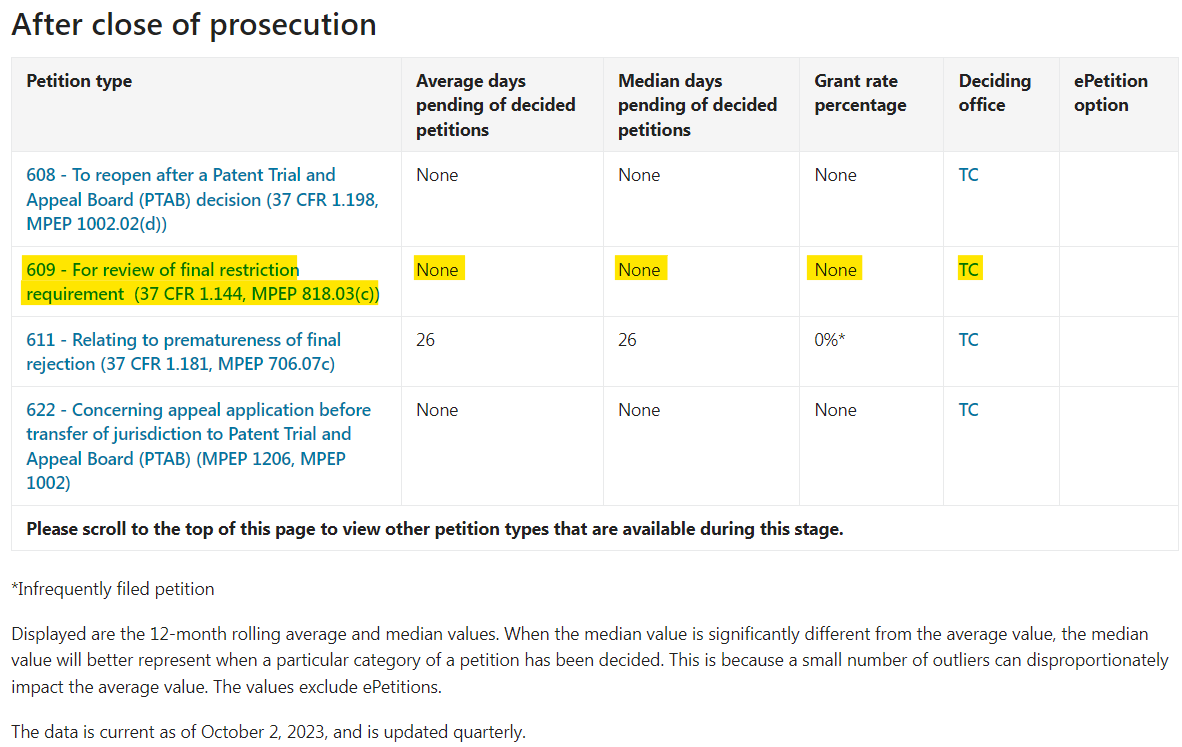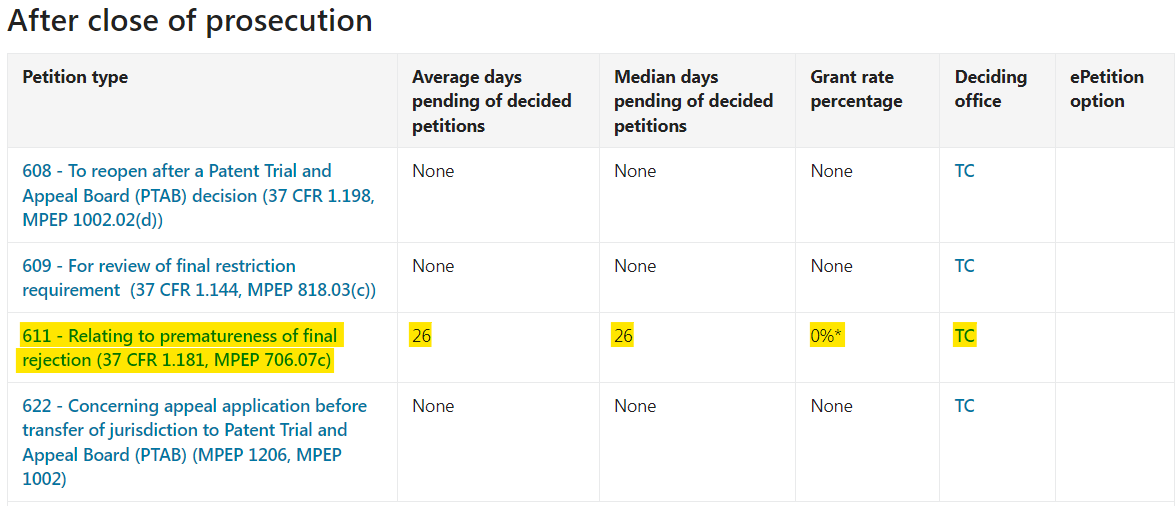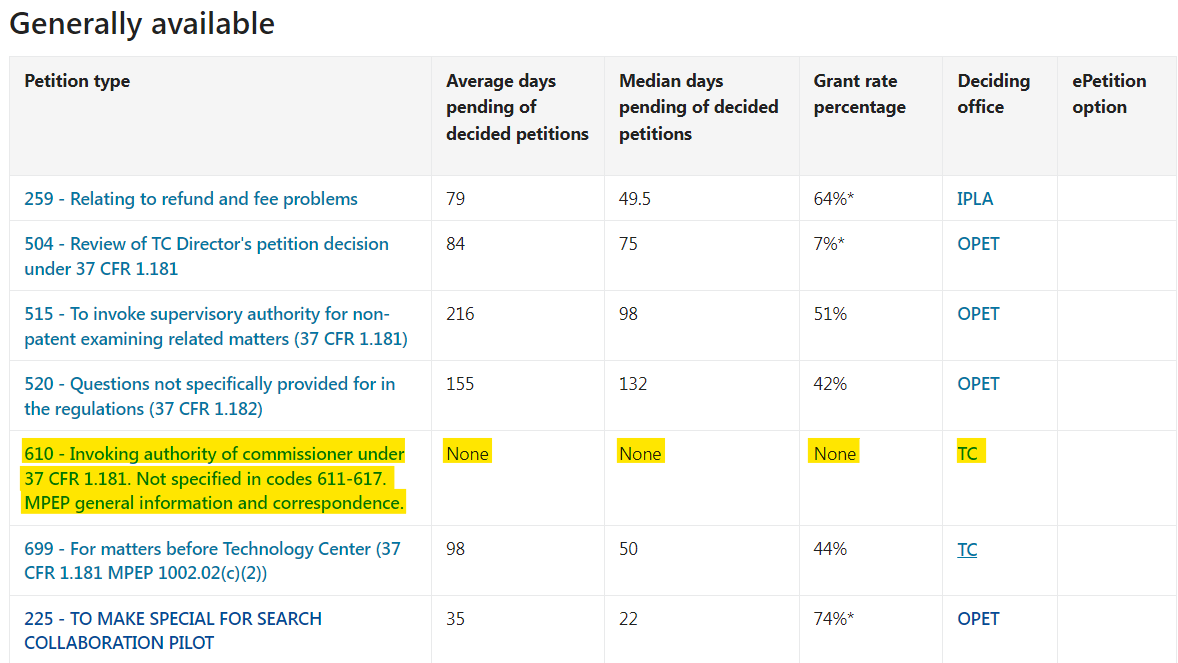USPTO Petition Statistics: Inaccurate and Misleading
Originally published on Petition.ai
Julie Burke, Ph.D.

Michael Spector

Practitioners rely upon information provided by the USPTO in order to make informed decisions about prosecution next steps. We have noticed inconsistent and shifting guidance on the USPTO’s Petition Webpage HERE and HERE. While policies are fluid, and the USPTO’s policies seem to be more fluid than permitted by the Administrative Procedures Act, data derived from the official electronic files should always be accurately reflected.
While recently researching petitions regarding final restriction requirements, we searched the USPTO’s Office of Petitions Timeline page to compare its average pendency and grant rates for these types of petitions with our database. We were extremely surprised to see there were no petition decisions regarding this petition type for the 12 months ending October 2, 2023. (see screenshot below).

Skeptical this information was accurate, we searched Petition.ai’s Petitions Database and found numerous decisions. In fact, we found 72 decisions about restriction requirements mailed in the 12 months ending September 30, 2023. Of these decisions, 48 of them were granted in whole or in part (67% grant rate) with an average pendency of 57 days and a median pendency of 43 days.
We also found inaccuracies with grant rates for petitions related to prematureness of final rejection. The USPTO petition dashboard indicated with an asterisk (*) that in their fiscal year 2023, this type of petition was infrequently filed and never granted. However, Petition.ai contains 94 such decisions with 49% granted in whole or in part. Also, the USPTO’s Patents Petitions Timeline showed average and median pendency of 26 days when, in fact, it should have showed 56 and 41 days, respectively.

Similar to inaccuracies with petition decisions related to final restriction requirements, we found the Petitions Timeline claimed there were no petition decisions related to invoking authority of commissioner under 37 CFR 1.181. Not specified in codes 611-617. MPEP general information and correspondence. (see screenshot below)

However, there were at least 52 decisions related to this petition type during the 12 months ending on September 30, 2023. Of the 52 decisions, only 9, or 17%, were granted with an average pendency of 48 days and a median pendency of 28 days
These inaccuracies are summarized below in Table 1.

Interestingly, all three of the data inaccuracies related to petitions decided in the Technology Centers. Anecdotally, we have heard of irregular and missing data reported to the Office of Petitions from Technology Centers.
This is not the first time we have noted inaccuracies in USPTO’s information, such as:
- In 2021, 84% of the retroactive foreign filing license petition decisions were missing from the electronic files
- In 2023, all 307 of the surveyed Climate Change Mitigation petitions were missing from the electronic files
Yet a review of the electronic files showed these petitions and their decisions were present in the official record.
Inaccurate Petition Statistics: Implications
According to the Office of Management and Budget’s Statistical Policy Directive No. 4,
Statistics produced by the Federal Government are used to shape policies, manage and monitor programs, identify problems and opportunities for improvement, track progress, and measure change. These statistics must meet high standards of reliability, accuracy, timeliness, and objectivity in order to provide a sound and efficient basis for decisions and actions by governments, businesses, households, and other organizations.
We note the invaluable role widely available, trustworthy, relevant, accurate and timely government statistics plays in helping IP practitioners make informed decisions.
The USPTO’s Patent Petitions Timeline data errors are not mere formalities. Because practitioners rely upon the USPTO, inaccurate statistics, like the ones noted above, are misleading. If patent practitioners believe that in its fiscal year 2023, the USPTO granted no petitions for withdrawing restriction requirements, withdrawing a premature final rejection of for other matters under 37 CFR 1.181, they may erroneously decide it is not worth their client’s time and effort to file such petitions, potentially missing out on advocating for additional client rights.
Business Professor and economist Aaron Levenstein once said, “statistics are like bikinis. What they reveal is suggestive, but what they conceal is vital.”
Here, the USPTO is concealing the fact that they are processing these types of petitions within 60 days, on average, with two of the petition types having grant rates of 67% and 49%.
By not being able to know actual grant rates and quick processing times, patent practitioners are unable to best advise their clients as to whether they should exercise their First Amendment rights to seek redress from the government by petitioning for relief of grievances.
The obviousness and extent of these inaccurate and misleading statistical errors calls into questions all the other pendency and grant rate statistics on the USPTO’s Patents Petitions Timeline.
Visit Petition.ai to obtain the most comprehensive and up-to-date petition information as well as to search for decisions pertaining to different types of petitions.



